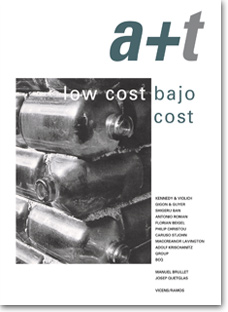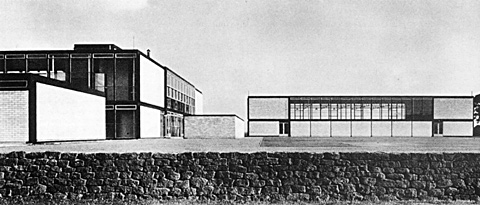
Low Cost
a+t 8
ISSN 1132-6409
1997
English/Spanish (23.5 x 32 cm)
136 Pages
CD Version: 18.00 €
Choose version
- CD Version: 18.00 €
Destination
Choose your country to calculate the shipping costs
What to do? First, we must question the traditional roles of this profession and second, propose new alternatives, discover new types of project, establishing closer and more involved links with customers, developing a business activity which will lead architects to overcome the fear of economic risk which characterises them.
Environmental concern and recycling of materials brings us face to face with the new role the architect must learn to play, with responsibility for sustainable development.

...The deregulation process which is to be introduced by the European Union will lead to the lowering of Architects’ fees which, in turn, will have a catalysing effect on the process of change which the architectural profession is to undergo over the next ten years.
Europe seems to have similar intentions to those of the United States when anti-trust legislation was passed in the seventies, by which the American Institute of Architects lost the right to maintain a fixed scale of fees.
Cuts in public investment introduced in order to comply with the unification of criteria regarding a reduction in public debt on the one hand, and a surplus of architecture-related services, in direct competition with engineers, and interior designers on the other, is giving rise to profound changes to the world of construction.
Three attitudes toward cost reduction
Kennedy & Violich Architecture
Gigon & Guyer
Shigeru Ban
...

...In Central Europe, the term neue Einfachheit seems to be coming into its own in order to group current architectures that point towards a new simplicity.1 New reviews of rationalism have appeared in countries with a deep-rooted gothic tradition, such as Switzerland, Austria, Germany, and even Great Britain. Some recent reviews relate this fact to the 20th century avant-gardes. Nevertheless, in my opinion, these architectures are more closely related to certain architecture which arose around the 1950’s than to the avant-gardes. The consolidation from the postwar period onwards of the so-called second nature, this one man-made, directly affects current architecture: i.e., the reconsideration of industrialization, of economy, and environment. Nowadays, this fact allows architectural positions pointing towards austerity, tinged with morality in the avant-gardes, to range from pragmatism to ecological consciousness...

...In the work of Florian Beigel and the Architecture Research Unit, (the experimental design office he directs at the University of North London) there is a strong desire to find ways of elevating architectural practice away from an over insistence and reliance on shape, form, and emphasis on the building as a singular commodity isolated from the conditions of change and exchange of a site. His projects are prototypical examples for the making of an openness in architecture, of bringing the outdoors into the indoors, of bringing a piece of city or landscape into a building, of finding means by which a sense of exteriority can be built. He has demonstrated this at the scale of the interior, at the scale of an urban buildings and at the scale of urban and landscape strategic planning...
















 I've read and agree to
I've read and agree to 


